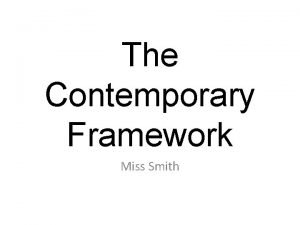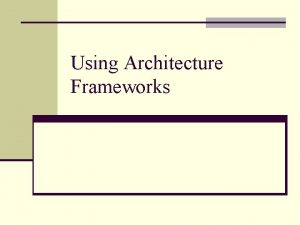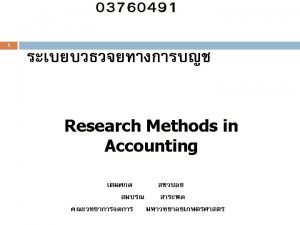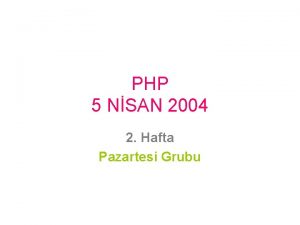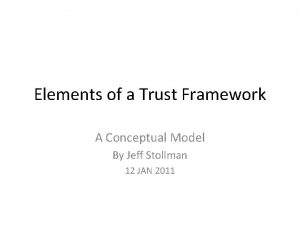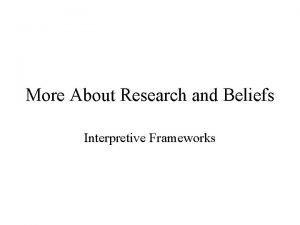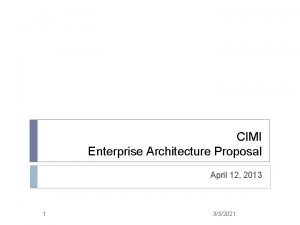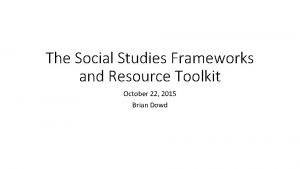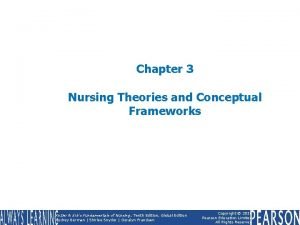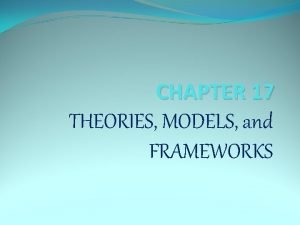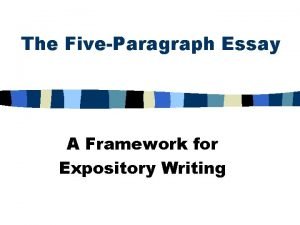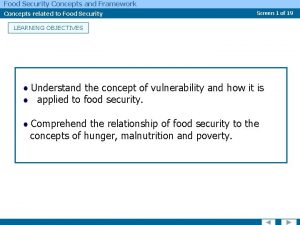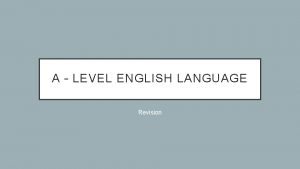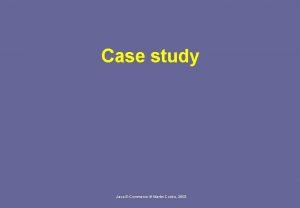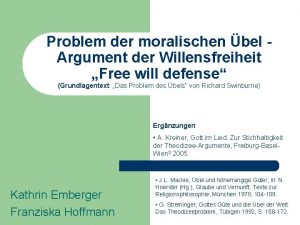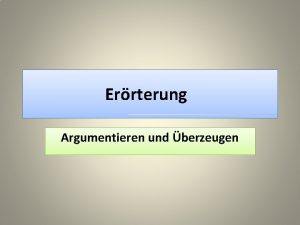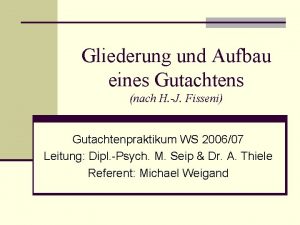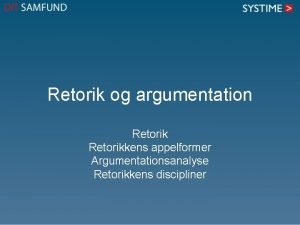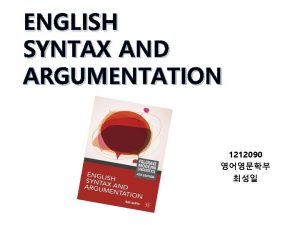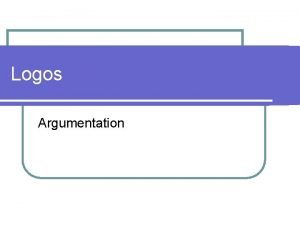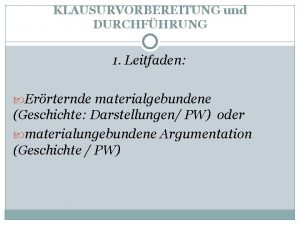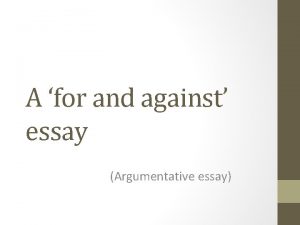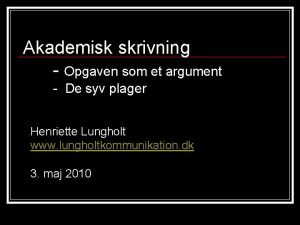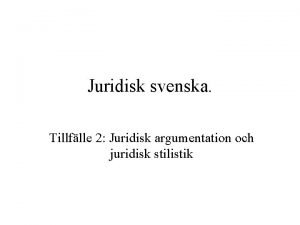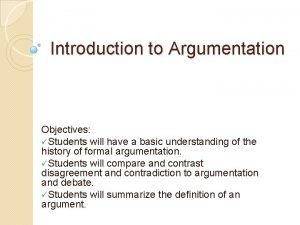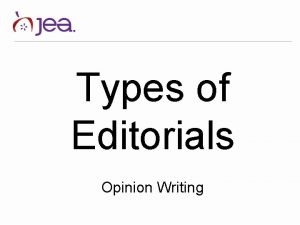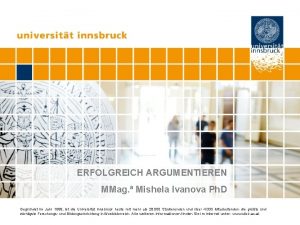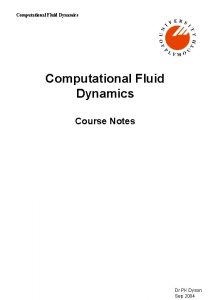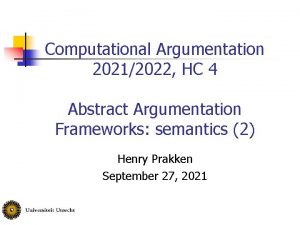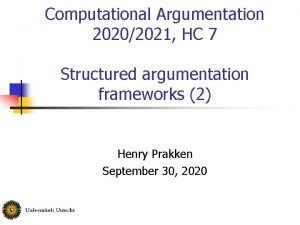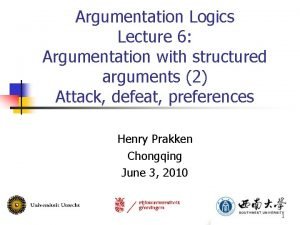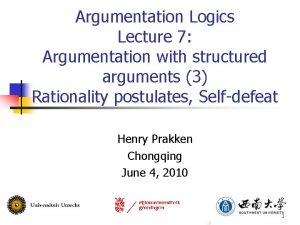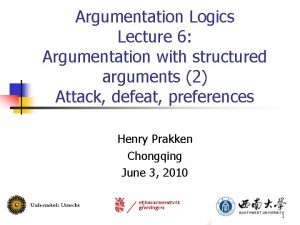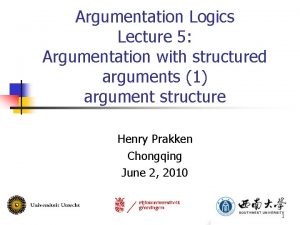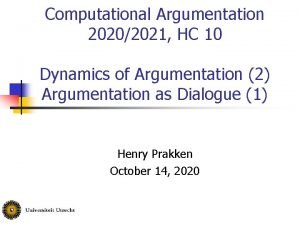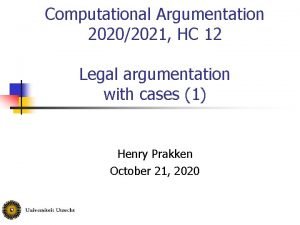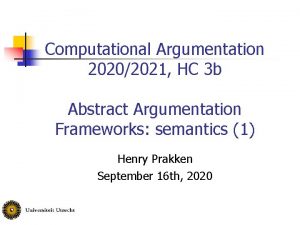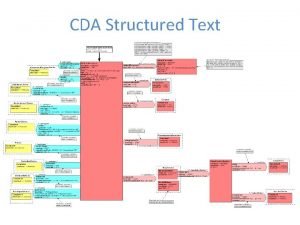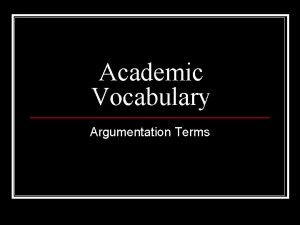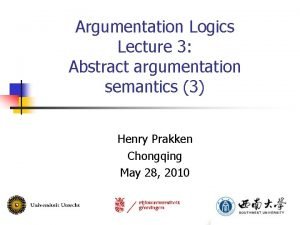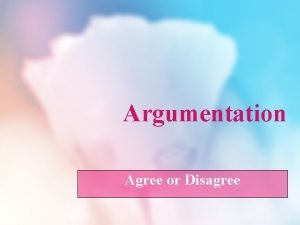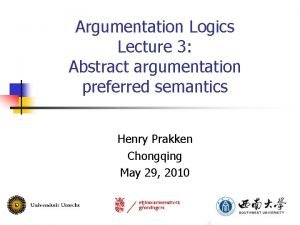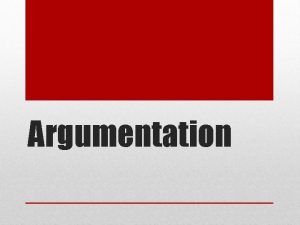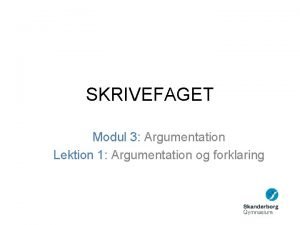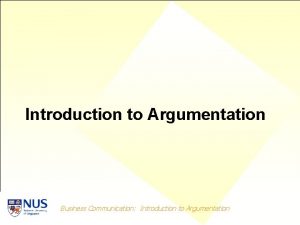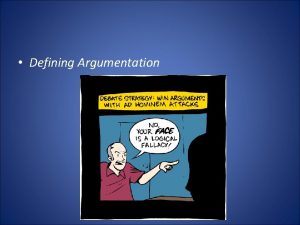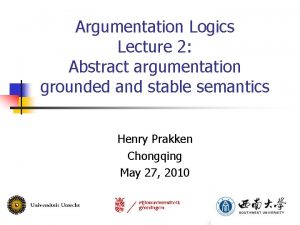Computational Argumentation 20212022 HC 6 Structured argumentation frameworks














































- Slides: 46

Computational Argumentation 2021/2022, HC 6 Structured argumentation frameworks (1) Henry Prakken October 4, 2021

A C B D E

We should lower taxes Lower taxes increase productivity Prof. P says that … People with political ambitions are not objective We should not lower taxes Increased productivity is good Prof. P is not objective Prof. P has political ambitions Lower taxes increase inequality Increased inequality is good Lower taxes do not increase productivity USA lowered taxes but productivity decreased Increased inequality is bad Increased inequality stimulates competition Competition is good 3

Overview n Structured argumentation frameworks: n n n Arguments Attack Defeat Generating abstract frameworks (Preference-based AFs) 4

Two accounts of the fallibility of arguments Tony Hunter Nicholas Rescher n Plausible Reasoning: all fallibility located in the premises n n n Defeasible reasoning: all fallibility located in the defeasible inferences n n Assumption-based argumentation (Kowalski, Dung, Toni, … Classical argumentation (Cayrol, Besnard, Hunter, …) Pollock, Loui, Simari, Vreeswijk, Prakken & Sartor, … ASPIC+ combines these accounts Robert Kowalski John Pollock 5

ASPIC+ framework: overview Argument structure: n Directed acyclic graphs where n n Nodes are wff of a logical language L Links are applications of inference rules n n n Rs = Strict rules ( 1, . . . , n ); or Rd= Defeasible rules ( 1, . . . , n ) Reasoning starts from a knowledge base K L Defeat: attack on conclusion, premise or inference, + preferences Argument acceptability based on Dung (1995) 6

Argumentation systems (with symmetric negation) n An argumentation system is a triple AS = (L, R, n) where: n n L is a logical language with negation (¬) R = Rs Rd is a set of strict ( 1, …, n ) and defeasible ( 1, …, n ) inference rules n: Rd L is a naming convention for defeasible rules Notation: n n - = ¬ if does not start with a negation - = if is of the form ¬ 7

Knowledge bases n A knowledge base in AS = (L, R, n) is a set K L where K is a partition Kn Kp with: n n Kn = necessary premises Kp = ordinary premises 8

Argumentation theories n An argumentation theory is a pair AT = (AS, K) where AS is an argumentation system and K a knowledge base in AS. 9

Structure of arguments n Top. Rule(A) An argument A on the basis of an argumentation theory is any structure obtained by applying the following steps a finite number of times: n if K with n n A 1, . . . , An if A 1, . . . , An are arguments such that there is a strict inference rule Conc(A 1), . . . , Conc(An) n n n Prem(A) = { }, Conc(A) = , Sub(A) = { }, Def. Rules(A) = Top. Rule(A) Prem(A) = Prem(A 1) . . . Prem(An) Conc(A) = Sub(A) = Sub(A 1) . . . Sub(An) {A} Def. Rules(A) = Def. Rules(A 1) . . . Def. Rules(An) A 1, . . . , An if A 1, . . . , An are arguments such that there is a defeasible inference rule Conc(A 1), . . . , Conc(An) n n Prem(A) = Prem(A 1) . . . Prem(An) Conc(A) = Sub(A) = Sub(A 1) . . . Sub(An) {A} Def. Rules(A) = Def. Rules(A 1) . . . Def. Rules(An) {A 1, . . . , An } 10

Rs : Rd : p, q s u, v w Kn = {q} p t s, r, t v w u, v w Rs p v p, q s Rs Kp = {p, r, u} A 1 = p A 5 = A 1 t A 2 = q A 6 = A 1, A 2 s A 3 = r A 7 = A 5, A 3, A 6 v A 4 = u A 8 = A 7, A 4 w u s, r, t v Rd p r s p p t n q p p t Rd p 11

Types of arguments n An argument A is: n n n Strict if Def. Rules(A) = Defeasible if not strict Firm if Prem(A) Kn Plausible if not firm S |- means there is a strict argument A s. t. n n Conc(A) = Prem(A) S 12

Rs : Rd : p, q s u, v w Kn = {q} p t s, r, t v w p v r p p t n q A 1 = p A 5 = A 1 t A 2 = q A 6 = A 1, A 2 s A 3 = r A 7 = A 5, A 3, A 6 v A 4 = u A 8 = A 7, A 4 w u p s Kp = {p, r, u} p p An argument A is: - Strict if Def. Rules(A) = - Defeasible if not strict - Firm if Prem(A) Kn - Plausible if not firm 13

Example R: n n n n d 1: p q d 2: s t d 3: t ¬d 1 d 4: u v d 5: v, x ¬t d 6: s ¬p s 1: p, q r s 2: v ¬s n(p q ) = d 1 Kn = {p}, Kp = {s, u, x} 14

n n n n d 1: p q d 2: s t d 3: t ¬d 1 d 4: u v d 5: v, x ¬t d 6: s ¬p s 1: p, q r s 2: v ¬s Kn = {p}, Kp = {s, u, x} r ¬t s 1 d 5 q p x v d 1 d 4 u 15

n n n n d 1: p q d 2: s t d 3: t ¬d 1 d 4: u v d 5: v, x ¬t d 6: s ¬p s 1: p, q r s 2: v ¬s Kn = {p}, Kp = {s, u, x} r ¬t s 1 d 5 q p x v d 1 d 4 u 16

Attack n n A undermines B (on ) if n Conc(A) = - for some Prem(B )/ Kn; A rebuts B (on B’ ) if n n A undercuts B (on B’ ) if n n Conc(A) = -Conc(B’ ) for some B’ Sub(B) with a defeasible top rule Conc(A) = -n(r ) ’for some B’ Sub(B ) with defeasible top rule r A attacks B iff A undermines or rebuts or undercuts B. 17

Rs : Rd : p, q s u, v w Kn = {q} p t s, r, t v w p v Kp = {p, r, u} A 1 = p A 5 = A 1 t A 2 = q A 6 = A 1, A 2 s A 3 = r A 7 = A 5, A 3, A 6 v A 4 = u A 8 = A 7, A 4 w u p r s p p t n q p p 18

n n n n d 1: p q d 2: s t d 3: t ¬d 1 d 4: u v d 5: v, x ¬t d 6: s ¬p s 1: p, q r s 2: v ¬s Kn = {p}, Kp = {s, u, x} r ¬t s 1 d 5 q p x v d 1 d 4 u 19

n n n n d 1: p q d 2: s t d 3: t ¬d 1 d 4: u v d 5: v, x ¬t d 6: s ¬p s 1: p, q r s 2: v ¬s Kn = {p}, Kp = {s, u, x} ¬d 1 r d 3 s 1 q p ¬t d 2 s x v t d 1 d 5 d 4 u 20

n n n n d 1: p q d 2: s t d 3: t ¬d 1 d 4: u v d 5: v, x ¬t d 6: s ¬p s 1: p, q r s 2: v ¬s Kn = {p}, Kp = {s, u, x} ¬d 1 r d 3 s 1 q p ¬t d 2 s x v t d 1 d 5 d 4 u 21

n n n n d 1: p q d 2: s t d 3: t ¬d 1 d 4: u v d 5: v, x ¬t d 6: s ¬p s 1: p, q r s 2: v ¬s Kn = {p}, Kp = {s, u, x} ¬d 1 r d 3 s 1 q p ¬t d 2 ¬p s x v t d 1 d 5 d 4 u d 6 s 22

n n n n d 1: p q d 2: s t d 3: t ¬d 1 d 4: u v d 5: v, x ¬t d 6: s ¬p s 1: p, q r s 2: v ¬s Kn = {p}, Kp = {s, u, x} ¬d 1 r d 3 s 1 q p ¬t d 2 ¬p s x v t d 1 d 5 d 4 u d 6 s 23

n n n n d 1: p q d 2: s t d 3: t ¬d 1 d 4: u v d 5: v, x ¬t d 6: s ¬p s 1: p, q r s 2: v ¬s Kn = {p}, Kp = {s, u, x} ¬d 1 r d 3 s 1 q p ¬t ¬s t d 1 d 5 d 2 ¬p s s 2 s d 4 u v d 6 x v d 4 u 24

n n n n d 1: p q d 2: s t d 3: t ¬d 1 d 4: u v d 5: v, x ¬t d 6: s ¬p s 1: p, q r s 2: v ¬s Kn = {p}, Kp = {s, u, x} ¬d 1 r d 3 s 1 q p ¬t ¬s t d 1 d 5 d 2 ¬p s s 2 s d 4 u v d 6 x v d 4 u 25

Structured argumentation frameworks n n Let AT = (AS, K) be an argumentation theory A structured argumentation framework (SAF) defined by AT is a triple (Args, C, a) where n Args = {A | A is an argument on the basis of AT} C is the attack relation on Args n a is an ordering on Args (A <a B iff A a B and not B a A) n n A c-SAF is a SAF in which all arguments have indirectly consistent premises (to be defined later) 26

Defeat n n A undermines B (on ) if n Conc(A) = - for some Prem(B )/ Kn; A rebuts B (on B’ ) if n n A undercuts B (on B’ ) if n n Conc(A) = -Conc(B’ ) for some B’ Sub(B ) with a defeasible top rule Which if B’ = means Conc(A) = -n(r) ’for some B’ Sub(B ) with defeasible top andrule notr. A < A defeats B iff for some B’ n n A undermines or rebuts B on B’ and not A < B’ ; or A undercuts B on B’ Direct vs. subargument attack/defeat Preference-dependent vs. preference-independent attacks 27

Abstract argumentation frameworks corresponding to SAFs n An abstract argumentation framework corresponding to a (c-)SAF = (Args, C, ) is a pair (Args, D) where D is the defeat relation on Args defined by C and . 28

The ultimate status of conclusions n With grounded semantics: n n With preferred semantics: n n A is justified if A g. e. A is overruled if A g. e. and A is defeated by g. e. A is defensible otherwise A is justified if A p. e for all p. e. A is defensible if A p. e. for some but not all p. e. A is overruled otherwise In all semantics: n n n is justified if is the conclusion of some justified argument (Alternative: if all extensions contain an argument for ) is defensible if is not justified and is the conclusion of some defensible argument is overruled if is not justified or defensible and there exists an overruled argument for 29

P is justified iff all extensions contain an argument with conclusion P (but it does not have to be the same argument) In preferred semantics P is justified, in grounded semantics P is not justified Brigt Rykkje likes ice skating Brigt Rykkje is Dutch Bright Rykkje is Norwegian Brigt Rykkje was born in Holland Brigt Rykkje has a Norwegian name 30

Example cont’d R: n n n n d 1: p q d 2: s t d 3: t ¬d 1 d 4: u v d 5: v, x ¬t d 6: s ¬p s 1: p, q r s 2: v ¬s n(p q ) = d 1 Kn = {p}, Kp = {s, u, x} 31

A B We should lower taxes Lower taxes increase productivity Prof. P says that … People with political ambitions are not objective We should not lower taxes Increased productivity is good Prof. P is not objective Prof. P has political ambitions C Lower taxes increase inequality Increased inequality is good Lower taxes do not increase productivity USA lowered taxes but productivity decreased D Increased inequality is bad Increased inequality stimulates competition E Competition is good

A C B D E

A B A’ C D E

P 1 P 2 P 3 A P 4 B A’ P 5 E D C P 6 P 7 P 8 P 9

36

A B C D

A 3 A 2 B 3 A 1 B 2 D 4 B 1 D 3 C 2 C 1

A 3 A 2 B 3 A 1 B 2 D 4 B 1 D 3 C 2 D 4 <a B 2 C 1

A 3 A 2 B 3 A 1 B 2 D 4 B 1 D 3 C 2 D 4 <a B 2 C 1

Preference-based abstract argumentation frameworks n PAFs: extend (args, attack) to (args, attack, ) n n Implicitly assumes that all attacks are: n n n a is an ordering on args A defeats B iff A attacks B and not A < B Apply Dung’s theory to (args, defeat) preference-dependent independent from each other Assumptions not satisfied in general => n n Properties not inherited by all instantiations possibly violation of rationality postulates 41

R 1: If you snore, you misbehave R 2: If you snore when nobody else is around, you don’t misbehave R 3: If you misbehave in the library, the librarian may remove you R 1 < R 2 < R 3 John may be removed R 3 John misbehaves in the library R 1 John snores in the library John does not misbehave in the library R 2 John snores when nobody else is in the library 42

R 1: If you snore, you misbehave R 2: If you snore when nobody else is around, you don’t misbehave R 3: If you misbehave in the library, the librarian may remove you R 1 < R 2 < R 3 John may be removed R 3 John misbehaves in the library R 1 John snores in the library John does not misbehave R 1 < R 2 in the library R 2 John snores when nobody else is in the library 43

R 1: If you snore, you misbehave R 2: If you snore when nobody else is around, you don’t misbehave R 3: If you misbehave in the library, the librarian may remove you R 1 < R 2 < R 3 A 3 so A 2 < B 2 < A 3 (with last link) John may be removed R 3 A 2 John misbehaves in the library B 2 R 1 A 1 John snores in the library John does not misbehave in the library R 2 B 1 John snores when nobody else is in the library 44

R 1: If you snore, you misbehave not recognise that R 2: If you snore when nobody else is around, you don’t. Does misbehave B 2’s attacks on A 2 and A 3 R 3: If you misbehave in the library, the librarian may remove you are the same R 1 < R 2 < R 3 so A 2 < B 2 < A 3 (with last link) attacks PAF-defeats A 3 Correct defeats A 3 A 2 B 2 A 1 B 1 45

Next lecture n n n Ways to choose the rules Preferences Rationality postulates 46
 How can we integrate oop with sd/sa
How can we integrate oop with sd/sa Disadvantages of unstructured interviews
Disadvantages of unstructured interviews Interpretive framework example
Interpretive framework example Enterprise agile frameworks
Enterprise agile frameworks Contemporary framework meaning
Contemporary framework meaning Knowledge frameworks
Knowledge frameworks Software architecture frameworks
Software architecture frameworks List of theoretical frameworks
List of theoretical frameworks Php frameworks
Php frameworks Describe trust frameworks.
Describe trust frameworks. I hate frameworks
I hate frameworks Parcc model content frameworks
Parcc model content frameworks Ethical framework
Ethical framework Interpretive framework
Interpretive framework Enterprise architecture proposal
Enterprise architecture proposal Liberta hax
Liberta hax Net frameworks 4
Net frameworks 4 Social studies toolkit
Social studies toolkit Actor frameworks
Actor frameworks The living tree of nursing theories
The living tree of nursing theories Cognitive message strategies
Cognitive message strategies Regional construction frameworks
Regional construction frameworks Nursing informatics theories, models and frameworks
Nursing informatics theories, models and frameworks Sub topic sentence
Sub topic sentence Local development frameworks
Local development frameworks Food security concepts and frameworks
Food security concepts and frameworks A level english language frameworks
A level english language frameworks Java ecommerce frameworks
Java ecommerce frameworks Free will defense theodizee
Free will defense theodizee Argumentation schreiben
Argumentation schreiben Unterschied lineare und dialektische erörterung
Unterschied lineare und dialektische erörterung Aufbau eines gutachtens
Aufbau eines gutachtens Argumentation og retorik
Argumentation og retorik English syntax and argumentation answer pdf
English syntax and argumentation answer pdf Logos argumentation
Logos argumentation Eine argumentation
Eine argumentation For and against essay linking words
For and against essay linking words Akademisk skrivning
Akademisk skrivning Linking words for arguments
Linking words for arguments Stilistisk term
Stilistisk term Types of deductive arguments
Types of deductive arguments Argumentation
Argumentation Tierversuche argumentation
Tierversuche argumentation Introduction to argumentation
Introduction to argumentation Editorial of argumentation
Editorial of argumentation De123rf
De123rf Computational fluid dynamics
Computational fluid dynamics




